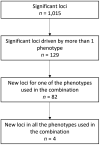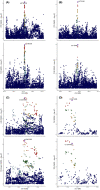Multi-phenotype analyses of hemostatic traits with cardiovascular events reveal novel genetic associations
- PMID: 35285134
- PMCID: PMC9314075
- DOI: 10.1111/jth.15698
Multi-phenotype analyses of hemostatic traits with cardiovascular events reveal novel genetic associations
Abstract
Background: Multi-phenotype analysis of genetically correlated phenotypes can increase the statistical power to detect loci associated with multiple traits, leading to the discovery of novel loci. This is the first study to date to comprehensively analyze the shared genetic effects within different hemostatic traits, and between these and their associated disease outcomes.
Objectives: To discover novel genetic associations by combining summary data of correlated hemostatic traits and disease events.
Methods: Summary statistics from genome wide-association studies (GWAS) from seven hemostatic traits (factor VII [FVII], factor VIII [FVIII], von Willebrand factor [VWF] factor XI [FXI], fibrinogen, tissue plasminogen activator [tPA], plasminogen activator inhibitor 1 [PAI-1]) and three major cardiovascular (CV) events (venous thromboembolism [VTE], coronary artery disease [CAD], ischemic stroke [IS]), were combined in 27 multi-trait combinations using metaUSAT. Genetic correlations between phenotypes were calculated using Linkage Disequilibrium Score Regression (LDSC). Newly associated loci were investigated for colocalization. We considered a significance threshold of 1.85 × 10-9 obtained after applying Bonferroni correction for the number of multi-trait combinations performed (n = 27).
Results: Across the 27 multi-trait analyses, we found 4 novel pleiotropic loci (XXYLT1, KNG1, SUGP1/MAU2, TBL2/MLXIPL) that were not significant in the original individual datasets, were not described in previous GWAS for the individual traits, and that presented a common associated variant between the studied phenotypes.
Conclusions: The discovery of four novel loci contributes to the understanding of the relationship between hemostasis and CV events and elucidate common genetic factors between these traits.
Keywords: blood coagulation; cardiovascular diseases; genetic pleiotropy; genome-wide association study; hemostasis.
© 2022 The Authors. Journal of Thrombosis and Haemostasis published by Wiley Periodicals LLC on behalf of International Society on Thrombosis and Haemostasis.
Conflict of interest statement
S.M. Damrauer is named as a co‐inventor on a government‐owned US Patent application related to the use of genetic risk prediction for venous thromboembolic disease filed by the US Department of Veterans Affairs in accordance with Federal regulatory requirements. All other authors have no conflicts of interest to declare.
Figures




References
-
- Junker R, Heinrich J, Schulte H, van de Loo J, Assmann G. Coagulation factor VII and the risk of coronary heart disease in healthy men. Arterioscler Thromb Vasc Biol. 1997;17:1539‐1544. - PubMed

